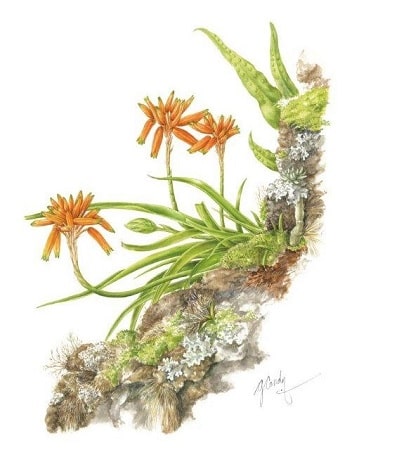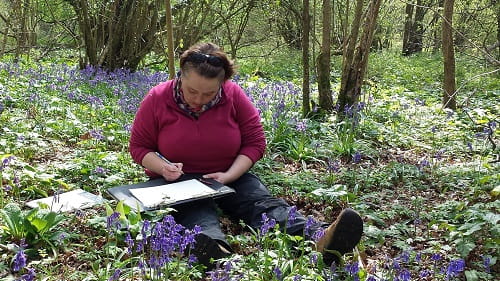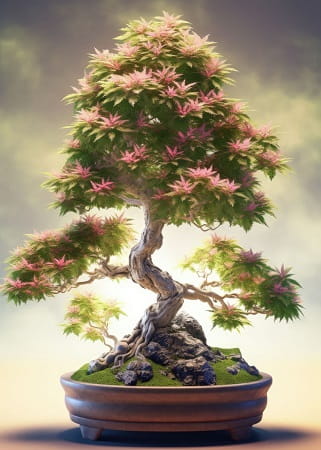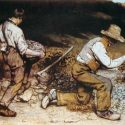Botanical Art
Botanical art has fascinated art enthusiasts and nature lovers alike for centuries. Botanical art, an age-old tradition, has woven the intricate tapestry of nature into the realm of artistry. It captures the intricate beauty of plants, flowers, and fruits in exquisite detail, merging scientific precision with artistic finesse. It’s a mesmerizing fusion of science and creativity, where artists meticulously capture the essence of plant life, revealing the hidden intricacies that often escape the naked eye. In this digital age, where the world moves at a rapid pace, botanical art stands as a testament to the unhurried beauty of the natural world.
In this post, we delve into the world of botanical art, exploring its rich history, techniques, and the mesmerizing allure that has made it a timeless artistic tradition.
Explore the Allure of Botanical Art: What is Botanical Art?
Understanding Botanical Art
Botanical art is more than just pictures of plants; it’s a blend of artistic skill and scientific observation.

Aloe nubigena, a native plant of South Africa, watercolor on paper by Gillian Condy – What is Botanical Art?
Botanical artists meticulously portray plant species, focusing on their unique features and botanical accuracy. Through detailed illustrations, these artworks serve as valuable records of plant life, making them invaluable to botanists and nature enthusiasts.
1- Scientific Accuracy
At the heart of botanical art lies scientific accuracy. Artists keenly observe plants, studying their unique features, such as leaves, stems, flowers, and fruits.
Every botanical illustration is a testament to the artist’s ability to capture not just the superficial appearance but also the inner workings of the plant, often including microscopic details that define its species.
2- Artistic Technique
Artists employ various techniques to recreate the lifelike qualities of plants on paper.
Watercolor is a popular choice due to its translucency, allowing artists to capture the delicate hues and gradations found in nature.

Opuntia cochenillifera Cacto palma, – Watercolor on paper, 2004 by Fatima Zagonel.
Pen and ink are used for intricate linework, highlighting the fine details of leaves and petals. Colored pencils offer precision, enabling artists to portray vibrant colors and textures realistically.
3- Observation from Life
Botanical artists often work directly from live specimens.
![[Cucurbita pepo] cultivar - Green Autumn Swan by Monica Ray](https://birsanatbirkitap.com/wp-content/uploads/2023/10/monica-ray-green-autumn-swan-cultivar.jpg)
[Cucurbita pepo] cultivar – Green Autumn Swan by Monica Ray.
Working with real plants allows artists to study their subjects in natural light, capturing the play of shadows and highlights that give depth to the artwork. This hands-on approach enhances the artist’s understanding of the plant’s form and structure, resulting in a more authentic representation.
4- Historical Significance: Why is Botanical Art Important?
Throughout history, botanical illustrations have played a vital role in scientific exploration. Before the advent of photography, these illustrations served as crucial documentation, aiding botanists in the classification of plant species.
Pioneering botanical artists like Pierre-Joseph Redouté and Margaret Mee made significant contributions to the field of botany through their detailed artworks.

Flowers by Pierre-Joseph Redouté (1759-1840) (Rosa centifolia, anemone, and clematis).
Recommended For You – The father of genetics, Gregor Mendel
5- Conservation and Awareness
In contemporary times, botanical art continues to contribute significantly to conservation efforts.

Passiflora incarnata, 2018 by Wei-Ting Chi.
Artists often focus on endangered or rare plant species, drawing attention to the importance of biodiversity and the need for conservation. Through their art, they raise awareness about vanishing plant species, highlighting their ecological significance.
6- Cultivation of Patience and Precision
Creating botanical art is a meticulous process that requires patience, precision, and a deep appreciation for nature. Artists spend hours, sometimes days, carefully observing, sketching, and painting each botanical specimen. This cultivation of patience and attention to detail is reflected in the final artwork, captivating viewers with its intricate beauty.

Fan Dance of the Red Oak (Quercus rubra), 2020 by Kelly Radding.
In essence, botanical art is not merely a representation of plants; it is a celebration of nature’s elegance and complexity. Each brushstroke, each detail, is a testament to the profound connection between art and science, inviting viewers to marvel at the wonders of the natural world through the eyes of a skilled artist.
Historical Significance
Botanical art traces back to ancient civilizations, where it was used for medicinal and scientific purposes. During the Renaissance, botanical illustrations flourished, with artists like Leonardo da Vinci and Albrecht Dürer creating stunning botanical masterpieces. This tradition continued through the centuries, evolving with changing artistic styles and technologies.

Columbines — watercolor by Albrecht Dürer (1471-1528) – Botanical Art.
1- Early Scientific Exploration
During the Age of Exploration, as voyagers traveled to distant lands, they encountered a myriad of unknown plant species.
Botanical artists accompanied these expeditions, meticulously documenting the newfound flora. These illustrations became invaluable references, aiding botanists in classifying and understanding these exotic plants. Through their detailed depictions, these artists bridged the gap between the unfamiliar and scientific comprehension.
2- Founding Modern Botany
The Age of Enlightenment marked a significant period for botanical art. As scientific inquiry flourished, botanists relied heavily on precise illustrations for their publications.

Brassica capitata, by Georg Dionysius Ehret.
Artists like Georg Dionysius Ehret and James Sowerby collaborated with prominent botanists, creating detailed illustrations that accompanied botanical texts. These collaborations formed the foundation of modern botany, establishing standardized representations of plant species and contributing to the development of scientific taxonomy.
3- Herbaria and Cataloging
Botanical art played a vital role in the creation of herbaria, collections of preserved plant specimens. Artists meticulously illustrated these specimens, ensuring accurate visual records of plant anatomy.
Herbaria became essential repositories, aiding botanists in their studies. The illustrations not only served as visual references but also enhanced the educational value of these collections, enabling botanists to share their knowledge across generations.
4- Educational Tools
Botanical illustrations became indispensable educational tools.
In the 18th and 19th centuries, botanical art adorned textbooks and educational materials, enabling students and enthusiasts to learn about plants in intricate detail. These illustrations, often combined with detailed descriptions, allowed for a comprehensive understanding of plant species, fostering a deep appreciation for botany among scholars and the general public alike.
5- Cultural and Artistic Influence
Beyond the realm of science, botanical art had a profound impact on art and culture.

American Wisteria by Melissa Fabian.
Artists drew inspiration from the natural world, incorporating botanical motifs into various art forms, including paintings, textiles, and ceramics. The delicate beauty captured in botanical illustrations influenced decorative arts and garden designs, shaping cultural aesthetics during different historical periods.
6- Conservation Advocacy
In the 19th and 20th centuries, botanical artists like Marianne North and Margaret Mee embarked on expeditions to document plant species in their natural habitats. Their artworks not only highlighted the diverse flora of regions such as the Amazon rainforest but also raised awareness about conservation. Through their art, they advocated for the preservation of endangered plant species and their habitats, pioneering early conservation efforts.

Nepenthes Northiana, 1876 by Marianne North (1830-1890) – Marianne North Gallery, Kew Gardens. The painting shows the pitcher plant’s lower and upper pitcher.
Botanical art, with its historical significance deeply rooted in scientific exploration, education, and cultural influence, continues to inspire contemporary artists and scientists.
As a testament to human curiosity and artistic creativity, these historical botanical illustrations stand as enduring treasures, connecting us with the rich tapestry of botanical knowledge forged by generations of artists and naturalists.
Techniques and Tools in Botanical Art
Botanical artists employ various techniques, including watercolor, pen and ink, and colored pencils, to bring plants to life on paper. They often work from live specimens, carefully observing every nuance of the plant they are depicting.
Botanical art is a meticulous craft that demands precision, patience, and a deep understanding of plant anatomy. Precision and attention to detail are paramount, resulting in artworks that are not only visually appealing but also scientifically accurate.
1- Observation and Sketching
The artistic process begins with keen observation. Botanical artists spend hours studying live plants, meticulously sketching their subjects. This initial stage allows artists to understand the plant’s structure, form, and unique characteristics. Through careful observation, artists capture the essence of the plant, laying the foundation for the detailed illustration to come.

British botanical artist Sarah Morrish, studying native bluebells. Photo courtesy Sarah Morrish.
2- Watercolor Painting
Watercolor is a popular medium in botanical art due to its transparency and ability to create delicate washes.
Artists layer washes of color to achieve the subtle gradients found in nature.

Dahlia ‘Sonic Bloom’, 2021 by Jean Emmons – Watercolor on vellum – Botanical Art.
Watercolor’s translucency allows artists to capture the luminosity of petals and leaves. By building up layers of color, artists create depth, bringing a three-dimensional quality to their illustrations.
3- Pen and Ink Detailing
Pen and ink are used for precise linework, defining the intricate details of leaves, stems, and floral elements.
Botanical artists use fine-tipped pens to create controlled lines, capturing the fine textures of plants. Cross-hatching and stippling techniques add depth and shading, enhancing the realism of the illustration.

Seeds and Seedpods by Sarah Morrish – 2020 Copyright Illustrating Natures Details/Sarah Morrish.
Pen and ink provide a level of precision that is essential for botanical accuracy.
4- Colored Pencils
Colored pencils are prized for their ability to create intricate, vibrant illustrations.
Botanical artists use layers of colored pencils to build up realistic textures and hues. The wax or oil-based pencils allow for precise shading and blending, enabling artists to capture the subtle variations in color and tone. Colored pencils are particularly effective in rendering botanical subjects with a high level of detail.
5- Digital Tools
In the digital age, many botanical artists incorporate digital tools into their workflow.
Digital tablets and styluses allow artists to create detailed illustrations directly on a screen, mimicking traditional techniques.
Digital platforms offer advantages such as unlimited color options, easy corrections, and the ability to work in various styles.

Cannabonsai by Morphic Prints – Digital botanical art.
Digital botanical art has gained popularity, especially for online exhibitions and publications.
6- Scientific Instruments
Botanical artists often use magnifying glasses and microscopes to study tiny details such as pollen grains, hairs, and intricate structures. These scientific instruments enable artists to capture the minutiae of plants, ensuring accuracy in their illustrations.
Close observation with these tools reveals hidden features that might be overlooked by the naked eye.

Rubus Ripening Blackberries by Jessica Daigle.
Botanical artists skillfully combine these techniques and tools, allowing them to capture the essence of plants with unparalleled accuracy and beauty. Each stroke of the brush or pen is a testament to the artist’s dedication to mastering nature’s palette, resulting in botanical illustrations that are not only aesthetically pleasing but also scientifically informative.
Appreciating Botanical Art Today: A Flourishing Tradition in the Modern Age
In today’s fast-paced digital world, botanical art continues to captivate audiences and artists alike, fostering a deep appreciation for the natural world and its intricate wonders.
1- Educational Exhibitions and Workshops
Botanical art exhibitions and workshops are held worldwide, bringing together artists, enthusiasts, and scientists. These events showcase the intricate beauty of botanical illustrations and educate the public about the importance of plants in our lives.
Workshops provide aspiring artists with opportunities to learn traditional techniques from masters of the craft, ensuring the continuation of this esteemed tradition.
2- Online Presence and Social Media
The digital age has given rise to online platforms where botanical artists can showcase their work to a global audience.
Social media platforms, art websites, and online galleries allow artists to share their creations, reaching people who may not have encountered botanical art otherwise. These platforms facilitate discussions, collaborations, and the exchange of ideas among artists and enthusiasts worldwide.
3- Integration with Technology
Botanical art has seamlessly integrated with technology. Digital tools and software enable artists to create stunning botanical illustrations on tablets and computers, expanding the possibilities of the art form.
Artists use digital platforms to experiment with styles, collaborate on projects, and engage with a broader audience. Virtual reality (VR) and augmented reality (AR) applications also provide innovative ways for viewers to interact with botanical art in immersive environments.
4- Influence on Contemporary Art
The precision and attention to detail exhibited in botanical art have influenced contemporary artists across various mediums. Elements of botanical illustration are often seen in modern paintings, sculptures, and mixed-media artworks.
Botanical artists draw inspiration from botanical forms, incorporating them into their creations and exploring the intersection between nature, science, and art.
5- Cultivation of Environmental Stewardship
Botanical art serves as a powerful medium to cultivate environmental stewardship. Through exhibitions, publications, and educational programs, artists convey the importance of preserving natural habitats and promoting sustainable practices. Their art encourages viewers to connect with nature on a profound level, fostering a sense of responsibility toward the environment.

Hyacinthus (Hyacinth),2000 by Jee-Yeon Koo – Botanical Art.
Botanical art continues to enchant viewers with its timeless beauty and scientific importance. Whether you are an art enthusiast, a nature lover, or a scientist, exploring the world of botanical art is a captivating journey. From its historical significance to modern-day interpretations, these masterpieces remind us of the intricate wonders of the natural world.
Explore the world of botanical art today and immerse yourself in the delicate strokes and vibrant hues that celebrate the flora around us.
References:
- https://www.botanicalartworldwide.info/
- https://www.asba-art.org/content.aspx?page_id=1024&club_id=92618&item_id=7442489
- https://www.asba-art.org/content.aspx?page_id=1024&club_id=92618&item_id=7442602
- https://en.wikipedia.org/wiki/Pierre-Joseph_Redout%C3%A9
- https://www.asba-art.org/content.aspx?page_id=1024&club_id=92618&item_id=7443263
- https://www.asba-art.org/content.aspx?page_id=1024&club_id=92618&item_id=7442625
- https://en.wikipedia.org/wiki/Georg_Dionysius_Ehret
- https://www.asba-art.org/content.aspx?page_id=1024&club_id=92618&item_id=7442762
- https://en.wikipedia.org/wiki/Marianne_North
- https://www.asba-art.org/content.aspx?page_id=1024&club_id=92618&item_id=7442740
- https://www.asba-art.org/content.aspx?page_id=1024&club_id=92618&item_id=7442740
- https://www.natures-details.com/pen-ink-botanical-gallery?pgid=ki5p53p6-78936dba-eb73-4b0c-8333-82c084f47ffa
- https://displate.com/displate/6653633
- https://www.asba-art.org/content.aspx?page_id=1024&club_id=92618&item_id=7442500
- https://www.asba-art.org/content.aspx?page_id=1024&club_id=92618&item_id=7443128
- https://www.asba-art.org/content.aspx?page_id=1024&club_id=92618&item_id=7442624








